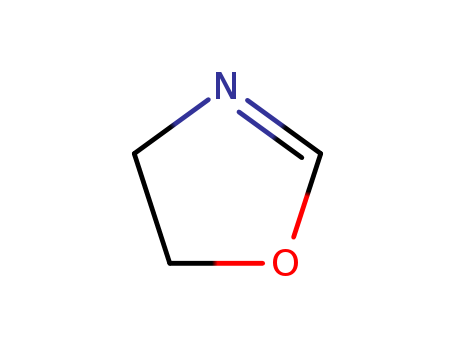10.1002/jhet.1902
The research focuses on the development of an efficient one-pot synthesis method for 2-oxazoline derivatives from ethyl α-cyanocinnamate derivatives using N-bromoacetamide (NBA) and potassium phosphate (K3PO4) as the base. The study was conducted at room temperature in acetone without the need for inert gas protection. The reaction yields were good to excellent (up to 98%) and were completed within 4.5 hours. A total of 13 examples were investigated, and the substrates were varied to include electron-donating and electron-withdrawing groups to assess the reaction's scope and limitations. The analysis involved monitoring the reaction progress using thin-layer chromatography (TLC) and determining the structures of the products through nuclear magnetic resonance (NMR) spectroscopy and high-resolution mass spectrometry (HRMS). The reaction mechanism was proposed based on the observed intermediates and the regioselectivity of the reaction, involving an aminobrominated intermediate and a cyclization process. The research also included the preparation of single crystals for X-ray crystallographic analysis to confirm the regiospecifity of the 2-oxazoline products.
10.1021/ol017113n
The study focuses on the highly selective asymmetric polymerization of 1,2-diisocyanobenzene to form enantiopure helical poly(quinoxaline-2,3-diyl) using a novel organopalladium initiator that contains the (4S,5S)-N-acyl-4,5-dihydro-4,5-diphenyl-1H-imidazol-2-yl group. This initiator serves as a polymer-end screw-sense-determinant, which is crucial for creating structurally well-defined helical polymers with a single screw-sense. The polymers, due to their helical structures, have potential applications as functional materials. The researchers explored alternative chiral groups that are easily accessible and provide efficient chiral environments, using chiral phenylpalladium initiators substituted with optically active o-substituents such as aminocarbonyl, oxazoline, and imidazoline groups derived from chiral amine precursors. The study aimed to develop a method for synthesizing polymers with stable single-handed screw-sense that do not undergo significant racemization, with the goal of achieving high screw-sense selectivity in the polymerization process.
10.1002/anie.201307069
The research focuses on the development of the first practical nickel-catalyzed Sonogashira cross-coupling reaction for the synthesis of substituted alkynes, specifically targeting non-activated secondary alkyl iodides and bromides. This innovative approach provides a new and efficient method for creating dialkylated asymmetric alkynes from readily available substrates. The study successfully demonstrated the effectiveness of the bis(oxazoline) family of ligands in mediating nickel-catalyzed C(sp)-C(sp3) cross-couplings of both secondary and primary alkyl halides under mild reaction conditions. The reaction exhibited good compatibility with a variety of synthetically important functional groups, making it suitable for the synthesis and modification of biologically relevant molecules. High diastereoselectivities were observed in C(sp)-C(sp3) cross-couplings with 1,3- and 1,4-substituted cyclohexyl iodides. Key chemicals used in the process include bis(oxazoline) ligands, nickel catalysts, terminal alkynes, non-activated secondary alkyl bromides and iodides, and various functional groups such as ether, fluoride, ketal, amide, sulfonamide, carbamate, and amine groups. The research concluded that this new reaction offers a valuable tool for the synthesis of substituted alkynes and could potentially be optimized for enantioselectivity in future studies.
10.1021/acs.orglett.1c01607
This research presents an enantioselective oxidative cyclization method for synthesizing highly enantioenriched oxazolines and oxazines from N-allyl carboxamides using a chiral triazole-substituted iodoarene catalyst. The study's purpose was to develop a practical approach for constructing chiral 5-membered N-heterocycles, including those with quaternary stereocenters, which are valuable as synthetic building blocks and core structural motifs in biologically active compounds. The method was found to be efficient, with yields up to 94% and enantioselectivities up to 98% ee. Key chemicals used in the process include N-allyl benzamide as the substrate, chiral iodoarene catalysts, acetonitrile as the solvent, Selectfluor as a co-oxidant, and trifluoroacetic acid (TFA) as an acid additive.
10.1021/ol049417q
The study presents a novel method for synthesizing 2-substituted oxazolines through rhodium-catalyzed coupling of alkenes with 4,4-dimethyl-2-oxazoline. The key chemicals involved are 4,4-dimethyl-2-oxazoline, various alkenes, a rhodium catalyst (1/2[RhCl(coe)2]2), and a phosphine hydrochloride salt (PCy3?HCl). The rhodium catalyst and phosphine salt work together to activate the C-H bond of the oxazoline, facilitating its addition to the alkene double bond. The method is notable for its mild reaction conditions, good yields, and excellent selectivity for linear products. It tolerates a variety of alkene substitution patterns and functional groups, making it a versatile alternative to hydroesterification, which typically requires handling of toxic CO gas and high-pressure equipment. The study also explores the optimization of reaction conditions, including the type of phosphine used, and demonstrates the potential for further functionalization of the oxazoline products.
10.1002/hlca.19870700426
The study, titled "Stereoselective Alkylation at C(α) of Serine, Glyceric Acid, Threonine, and Tartaric Acid Involving Heterocyclic Enolates with Exocyclic Double Bonds," investigates the stereoselective alkylation of various chiral, non-racemic α-amino acids and their derivatives using heterocyclic enolates with exocyclic double bonds. The researchers converted these acids into methyl dioxolane, oxazoline, and oxazolidine carboxylates. These compounds were then deprotonated to form lithium enolates, which were stable enough to undergo alkylation with or without cosolvents like HMPA or DMPU. The products were obtained in good to excellent yields and with high diastereoselectivities, except for the tartrate-derived acetonide. The study demonstrated that the configuration of the products could be determined through NOE-NMR measurements and chemical correlation, revealing that the dioxolane-derived enolates were alkylated preferentially from the face already substituted, while the dihydrooxazol- and oxazolidine-derived enolates were alkylated from the opposite face. This work provides a method for constructing quaternary stereogenic centers without racemization, using readily available enantiomerically pure precursors like hydroxy- and amino-acids.
10.1021/jo00140a012
The research presents two synthetic approaches to the title compound, a potential new anxiolytic agent. The study aims to develop efficient synthetic routes to this compound, with the regiospecific formation of an aryl-aryl bond being the key step. The first synthesis involves a series of transformations starting from 2-(methoxyaryl)oxazolines, while the second approach uses vinyl lactam as an immediate precursor. Key chemicals used include oxazolines, benzophenone derivatives, (o-fluorophenyl)lithium, and various organometallic reagents. The study concludes that both methods are viable, with the second approach offering an improved yield of 23% in eight steps. The research highlights the importance of the nature of the organometallic nucleophile and its need for coordinating ligands in achieving successful aryl-aryl bond formation.





